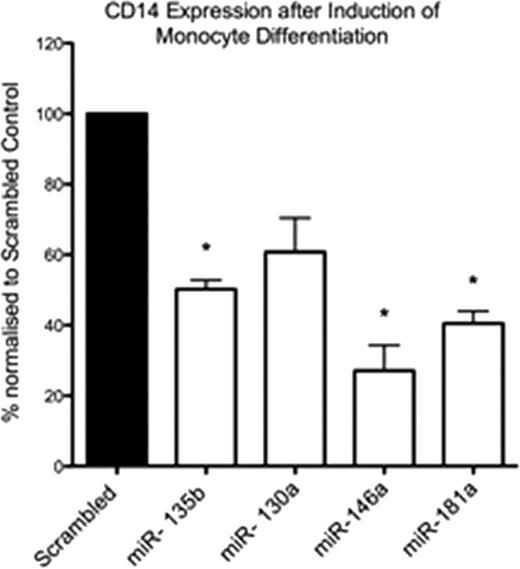Abstract
Abstract 2430
Acute myeloid leukaemia (AML) is typified by an aberrant halt in maturation of myeloid progenitor cells, leading to uncontrolled proliferation of immature blasts. In the majority of cases of AML with normal karyotype, the underlying cause of the maturation arrest remains unclear. MicroRNAs, small inhibitory RNAs, are known to be dysregulated in cancers and have been postulated to play a causative role in leukaemogenesis.
We aimed to investigate the contribution of aberrant microRNA expression to the inhibition of maturation in AML cells. MicroRNA expression profiling was performed on the bone marrow of 28 AML patients with normal karyotype and 8 normal controls. Differential expression was confirmed by qRT-PCR. We found that the expression of a panel of 12 microRNAs was able to accurately separate AML-M1 and AML-M5 subtypes. The AML-M1 subtype represents a more immature cell population when compared to the monoblast morphology observed in AML-M5. Four candidate microRNAs, miR-181a, -146a, -130a and -135b were selected for further investigation based in their putative targeting of key monocytic transcription factors as determined by in silico modelling followed by luciferase assays.
In vitro monocyte and macrophage differentiation of HL60 and NB4 cell lines with 1,25-dihydroxyvitamin D3 and/or phorbol-12-myristate-13-acetate treatment resulted in a significant decrease in all four candidate microRNAs (measured by qRT-PCR), supporting the hypothesis that candidate microRNA over-expression in AML-M1 may contribute to its maturation arrest. Over-expression of the candidate microRNAs by transfection with Pre-miR microRNA precursor molecules (Ambion) into the HL60 and NB4 monocyte differentiation model, resulted in the significant suppression of CD14 (Figure, *p <0.05 compared to Scrambled control) and CD15 expression, markers of monocytes and granulocytes respectively. Conversely, knockdown of miR-181a, -146a, -130a and -135b with miRCURY LNA microRNA knockdown probes (Exiqon) induced an increase in CD14 expression in HL60 cells compared to non-targeting Scrambled control.
No relevant conflicts of interest to declare.
Author notes
Asterisk with author names denotes non-ASH members.


This feature is available to Subscribers Only
Sign In or Create an Account Close Modal